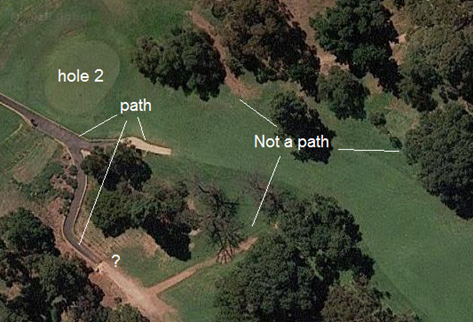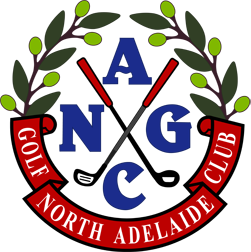Rule of the Month
This page will be used to regularly provide Match Committee approved interpretations of the rules of golf as they would be applied on the North Adelaide Golf Course.
Left Click the link to view the pdf document
April 2019
NAGC Rule of the Month April 2019 - Sprinkler Heads Adjacent to Greens (Local Rule).pdf
March 2019
NAGC Rule of the Month March 2019 - Complete Relief.pdf
November 2018
NAGC Rule of the Month Nov 2018 - Ball Played As It Lies.pdf
OCTOBER 2018
Left click the link below to view the pdf document
NAGC-Rule-of-the-Month - Matchplay.pdf
AUGUST 2018
RULE OF THE MONTH - DROPPING THE BALL
Left click the link below to view the pdf document with illustrations and active links to the R&A website for images and explanations of each rule & subject.
NAGC-Rule-of-the-Month - Dropping the Ball_MM.pdf
The relevant rule for this situation is Rule 20-2 Dropping and Re-Dropping . There are also a
number of decisions on the rules of golf that apply.
MAY 2018
RULE OF THE MONTH - CART PATHS
An ‘obstruction’ is anything artificial, including the artificial surfaces and sides of roads and paths, therefore, the cart paths and roads that we encounter on our regular rounds of golf at North Adelaide are obstructions. (Definitions – Obstructions)
Questions:
- Is a player allowed to take relief if their ball is on a cart path?
- If the player's ball is not on the cart path, but to play the ball normally they would have to stand on the cart path, may the player take relief?
- If the cart path is between the player and the green, and the player wants to putt, may they take relief from the cart path?
- If the ball is next to a slightly raised cart path (but not on or touching it), and the player will not be standing on the path to make their normal stroke, is the player entitled to relief if their normal swing would cause the club to strike the raised edge of the path?
Answers at the end of this article.
So – how do we identify what is, and what is not, a cart path?
Decision 24/9 states:
An artificially surfaced road or path is an obstruction, but what constitutes artificial surfacing?
A road or path to which any foreign material such as concrete, tar, rubber, gravel, stone, crushed shell, wood chips etc. has been applied is artificially surfaced.
Let’s look at some examples closer to home – how about Hole 2 on the South Course.
- Starting at the tee, there is a cart path the whole way along the right had side of the tee, and extends a little bit further; but where does it end?
The hard earth surface caused by traffic moving from the path to the fairway is not part of the path, and therefore a player is not entitled to relief. In the absence of a clearly defined end to a path, the player should determine the end of the path as the point between where the greenkeepers have applied the artificial surface and where the stones and gravel have been spread by traffic moving from the path to the fairway.
- Just before the dogleg, there is a stretch of hard earth near the Moreton Bay figs on the right-hand side, running from the 1st tee to the 2nd fairway. This has been caused by the greenkeepers’ vehicles, so is it a cart path or road?
It is neither a cart path, nor a road; whilst the ground is bare as a result of vehicular traffic, it has not been artificially surfaced, therefore it is not an obstruction and no relief may be taken.
The same applies to the stretch of bare earth further up on the right coming down the hill.
- On the left hand side of the green is a path which is covered with a rubberised coating between the 2nd green and the 3rd tee, and then extends with a gravel/stone covering a few meters down the hill on the left hand side of the fairway. Both these sections are clearly defined; the rubberised part by low stone walls, and the gravel part edged by grass. These are both obstructions and a player is entitled to relief.

- – the player can only take relief within one club-length and no nearer the hole than the nearest point of relief, so they would be well advised to assess where their nearest point of relief will be before marking and lifting their ball.
For example; if the ball has come to rest on the rubberised section of the cart path where it splits between the 2nd and 3rd holes, the nearest point of relief may be in the bushes over the wall further down the hill. It may be better for the player to attempt to play the ball off the path, rather than drop the ball into a potentially unplayable lie in the bushes.
Answers:
- Yes – a cart path is an immovable obstruction, so the player would be entitled to take relief under rule 24-2(b)
- Yes – rule 24-1(a) states that interference occurs “…when the obstruction interferes with the player’s stance…”.
- No – rule 24-1(a) states that “…interference on line of play is not, of itself, interference…”
- Yes – a player is entitled to relief if the obstruction interferes with the player’s area of intended swing. Rule 24-1(a)
APRIL 2018
ADVICE INDICATING LINE OF PLAY – Rule 8
Players cannot give advice to other players, except their own partner, during a round.
Players can’t ask for advice from anyone besides their partner or the partner’s caddie.
Example:
Before playing a shot to a green, a player may not ask another what club he/she hit for the same or similar shot; players are not allowed to ask for or give swing pointers during a round.
Exception:
Competitors may exchange distance information, such as the yardage from a player’s ball to the hole.
Players are allowed to have the intended line of a shot indicated to them by anyone, except on the putting green. The player cannot position someone on or close to their line either in front of or behind the hole while he/she is playing.
On the green, players are allowed to have the intended line pointed to by a caddie or partner before the stroke, as long as the person doesn’t touch or place a marker on the green.
Exception: The flagstick can be tended or held up for the player to see.
Penalties: Match play – loss of hole, Stroke play – two strokes.
MARCH 2018
SITUATION
The Green Keepers have been using a hose to water the trees on the left hand side of the fairway on the uphill approach to the 18th Green.
The hose has been left close to the edge of the fairway and your ball comes to rest close to the hose which will interfere with your stance or the area of your intended swing. Is the player allowed to take relief? - Yes!!
Questions:
- What if the ball was close to the hose which interferes with the players intended stance? – The player may take relief (24.2b)
- Does the player have to take relief? Could they stand on the hose and play their shot? –yes, they can stand on the hose to play their shot.
- What if the hose does not interfere with the players stance or area of intended swing, but is a meter in front of the ball and is distracting the player? – No relief.
- What if the hose is on the fringe of the green a meter in front of the players ball and the player wants to putt? – No relief
RULE
On our course hoses are considered as an immovable obstruction and you may take relief.
DO NOT MOVE THE HOSE
To take relief a player may lift the ball and drop it, without penalty, within one club length of and not nearer the hole than the nearest point of relief.
Note that the nearest point of relief may be in the rough but may not be in a hazard or on the putting green.
The following are examples of immovable obstructions on our course
Sprinkler heads, hoses, rubbish bins, computer boxes, garden seats, sand bins, distance indicators, stone or brick walls, steps and handrails. Paths covered in an artificial material (i.e. metal, bark pieces, woodchips etc). Garden beds defined by BLACK stakes.
Greenkeepers compound: defined by concrete border, black stakes and the roadway. Rule 24-2(b) and Rule 25
